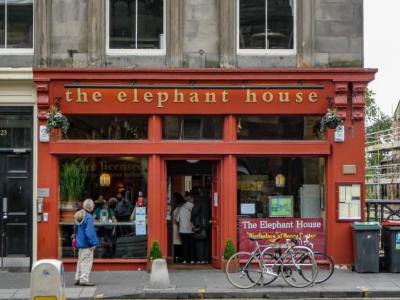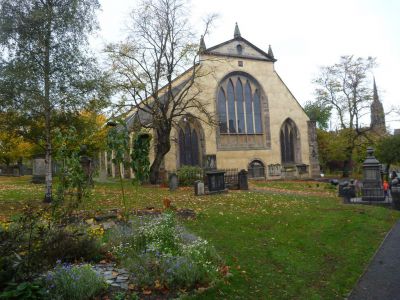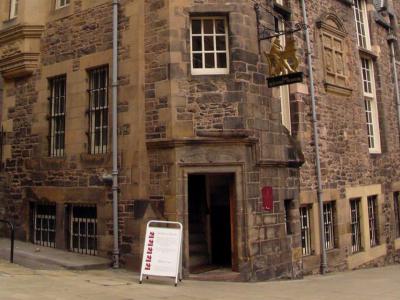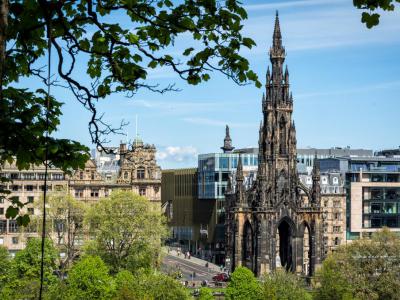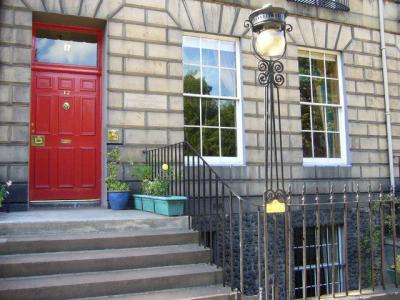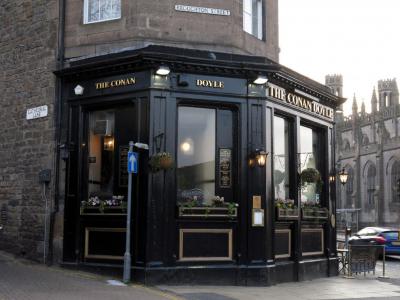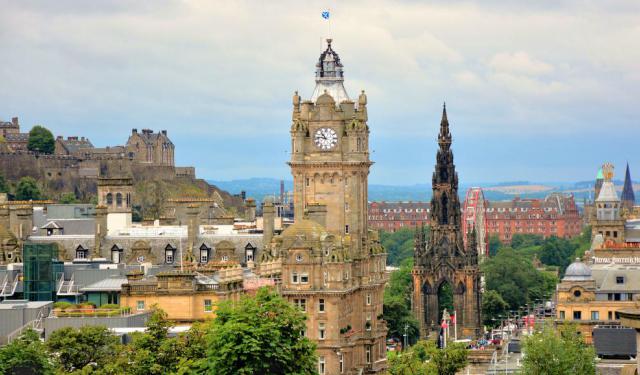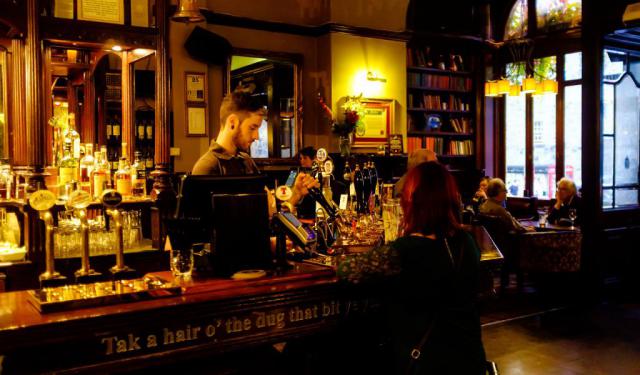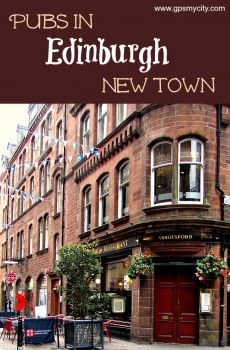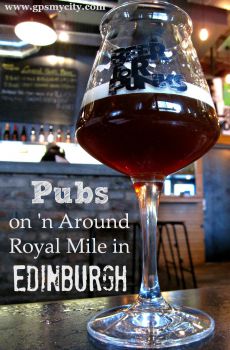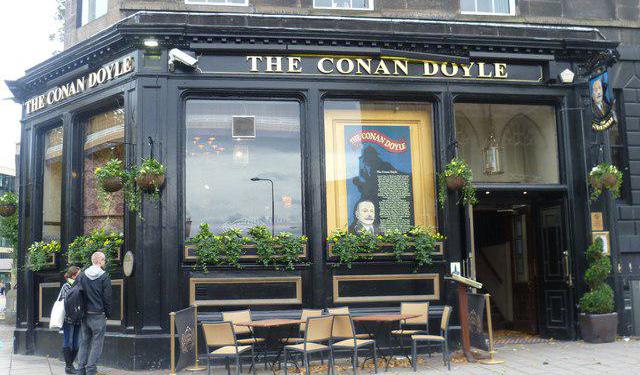
Literary Landmarks Tour (Self Guided), Edinburgh
For centuries, Edinburgh has been home to numerous writers. The likes of Robert Burns, Robert Louis Stevenson, and JK Rowling, just to name a few, have given pride to this city. Fortunately, the tradition doesn't seem to die out any time soon, as Edinburgh keeps producing more and more authors and literary heroes in whose footsteps people still wish to tread.
Naturally, there is a wealth of iconic landmarks in Edinburgh that left an indelible mark on the world of literature. These locations offer a glimpse into the capital's literary history and its influence on renowned authors.
The Elephant House, a cozy café nestled in the heart of Edinburgh, is famous as the birthplace of JK Rowling's Harry Potter series. Today, this charming spot has become a pilgrimage site for fans of the wizarding world.
Another must-visit site for Harry Potter fans is Greyfriars Church. Hidden behind the Elephant House Café, this historic church's graveyard is said to have inspired (at least in terms of names) some of the book's characters, like Tom Riddle (Lord Voldemort), derived from the grave of Thomas Riddell here.
The Writers' Museum and Makar's Court is a treasure trove for lovers of Scottish literature. Located on the Royal Mile, this museum honors Scotland's literary greats, like Robert Burns, Sir Walter Scott, and Robert Louis Stevenson. Makar's Court, just outside the museum, features inscriptions of quotes from various Scottish men of letters.
The Scott Monument, a towering Gothic structure dedicated to Sir Walter Scott, offers breathtaking panoramic views of the city. Scott's prolific works, including "Waverley" and "Ivanhoe," continue to captivate readers worldwide to this day.
Robert Stevenson's Childhood Home, the birthplace of the famous author of "Treasure Island" and "Doctor Jekyll and Mister Hyde," provides a glimpse into his early life and inspiration for his adventurous tales.
For fans of detective fiction, The Conan Doyle Pub pays homage to the creator of Sherlock Holmes, Sir Arthur Conan Doyle. Enjoy a pint of ale and immerse yourself in the world of the brilliant detective.
A seasoned bookworm or simply one curious about the city's literary heritage will find these sites equally interesting. So, embark on this literary pilgrimage, explore the stories that shaped Edinburgh, and be inspired by the words of the great writers who once graced these locations with their presence.
Naturally, there is a wealth of iconic landmarks in Edinburgh that left an indelible mark on the world of literature. These locations offer a glimpse into the capital's literary history and its influence on renowned authors.
The Elephant House, a cozy café nestled in the heart of Edinburgh, is famous as the birthplace of JK Rowling's Harry Potter series. Today, this charming spot has become a pilgrimage site for fans of the wizarding world.
Another must-visit site for Harry Potter fans is Greyfriars Church. Hidden behind the Elephant House Café, this historic church's graveyard is said to have inspired (at least in terms of names) some of the book's characters, like Tom Riddle (Lord Voldemort), derived from the grave of Thomas Riddell here.
The Writers' Museum and Makar's Court is a treasure trove for lovers of Scottish literature. Located on the Royal Mile, this museum honors Scotland's literary greats, like Robert Burns, Sir Walter Scott, and Robert Louis Stevenson. Makar's Court, just outside the museum, features inscriptions of quotes from various Scottish men of letters.
The Scott Monument, a towering Gothic structure dedicated to Sir Walter Scott, offers breathtaking panoramic views of the city. Scott's prolific works, including "Waverley" and "Ivanhoe," continue to captivate readers worldwide to this day.
Robert Stevenson's Childhood Home, the birthplace of the famous author of "Treasure Island" and "Doctor Jekyll and Mister Hyde," provides a glimpse into his early life and inspiration for his adventurous tales.
For fans of detective fiction, The Conan Doyle Pub pays homage to the creator of Sherlock Holmes, Sir Arthur Conan Doyle. Enjoy a pint of ale and immerse yourself in the world of the brilliant detective.
A seasoned bookworm or simply one curious about the city's literary heritage will find these sites equally interesting. So, embark on this literary pilgrimage, explore the stories that shaped Edinburgh, and be inspired by the words of the great writers who once graced these locations with their presence.
How it works: Download the app "GPSmyCity: Walks in 1K+ Cities" from Apple App Store or Google Play Store to your mobile phone or tablet. The app turns your mobile device into a personal tour guide and its built-in GPS navigation functions guide you from one tour stop to next. The app works offline, so no data plan is needed when traveling abroad.
Literary Landmarks Tour Map
Guide Name: Literary Landmarks Tour
Guide Location: Scotland » Edinburgh (See other walking tours in Edinburgh)
Guide Type: Self-guided Walking Tour (Sightseeing)
# of Attractions: 6
Tour Duration: 1 Hour(s)
Travel Distance: 2.9 Km or 1.8 Miles
Author: Helen
Sight(s) Featured in This Guide:
Guide Location: Scotland » Edinburgh (See other walking tours in Edinburgh)
Guide Type: Self-guided Walking Tour (Sightseeing)
# of Attractions: 6
Tour Duration: 1 Hour(s)
Travel Distance: 2.9 Km or 1.8 Miles
Author: Helen
Sight(s) Featured in This Guide:
- The Elephant House
- Greyfriars Church
- Writers' Museum & Makar’s Court
- Scott Monument
- Robert Stevenson's Childhood Home
- The Conan Doyle Pub
1) The Elephant House
Established since 1995, The Elephant House in Edinburgh has been renowned as one of the top destinations for tea and coffee connoisseurs. At some point, the place also grew famous through its association with J.K. Rowling, author of the bestselling Harry Porter series, who used to frequent this place, as an emerging writer, and wrote her early novels while sitting in the back room overlooking Edinburgh Castle.
Other literary patrons of The Elephant House, over the years, have included Ian Rankin, author of the Rebus novels, and Alexander McCall-Smith, author of The No.1 Ladies' Detective Agency, 44 Scotland Street and other novel series.
So, if you consider a writing career for yourself or seek inspiration, or simply want to savour a nice cup of tea or coffee prior to venturing out into historic Edinburgh, feel free to pop in and enjoy the place!
Other literary patrons of The Elephant House, over the years, have included Ian Rankin, author of the Rebus novels, and Alexander McCall-Smith, author of The No.1 Ladies' Detective Agency, 44 Scotland Street and other novel series.
So, if you consider a writing career for yourself or seek inspiration, or simply want to savour a nice cup of tea or coffee prior to venturing out into historic Edinburgh, feel free to pop in and enjoy the place!
2) Greyfriars Church
With a clear division into the Old and New Town, it's not hard to locate ancient buildings in Edinburgh. One such building – Greyfriar’s Church – is part of the Old Town.
Construction on the church began in 1602 and it was consecrated in 1630, becoming one of the oldest buildings in the Old Town. It was put up on the site of an abandoned Franciscan monastery and took its name from the monks who wore grey cassocks and were called “Grey Friars”.
In 1718, a dividing wall split the nave between the Old Greyfriars and New Greyfriars, so as to separate the Covenanters from the Roman Catholics worshipping inside the same church. In 1845, parts of the roof and the interior were destroyed by fire.
During restorations in the mid 19th century, beautiful stained-glass windows were added. It was the first time that such windows appeared in a Presbyterian church and it caused a bit of a scandal. A little later, an organ was added, causing yet another scandal. In 1929, the church was further renovated and, this time, the dividing wall was removed.
The adjoining graveyard is said to be haunted by the ghost of George Mackenzie, called the “Bloody” Lord Advocate for being responsible for the persecution of the Covenanters. According to legend, wherever his hand touches a living person, it leaves cuts and bruises.
Today the church hosts fashion shows, exhibitions, lectures and drama productions. The onsite museum showcases artefacts found in the area and recounts a comprehensive history of the Covenanters.
***Literary Landmarks & Harry Potter Tour ***
Hidden behind the Elephant House Café lies the historic Greyfriars Kirkyard which is now a place of interest for avid Harry Potter fans. Found here the grave of Thomas Riddell is said to have inspired JK Rowling to create the Tom Riddle (aka Lord Voldemort) character. Also, visible from here George Heriots School is said to be the template for fictional Hogwarts.
In addition to the gravestones of Robert Potter, Tom Riddell and William McGonagall found in the cemetary, there are others with potential links, such as Elizabeth Moodie (Mad-Eye Moody?) and Margaret Louisa Scrymgeour Wedderburn (Rufus Scrimgeour, the Minister of Magic in the final Harry Potter book?).
Starting August 2019, there is a Greyfriars Kirkyard map available to buy, locating all of the Harry Potter-themed gravestones. Proceeds from sales go to the upkeep of the grounds.
Construction on the church began in 1602 and it was consecrated in 1630, becoming one of the oldest buildings in the Old Town. It was put up on the site of an abandoned Franciscan monastery and took its name from the monks who wore grey cassocks and were called “Grey Friars”.
In 1718, a dividing wall split the nave between the Old Greyfriars and New Greyfriars, so as to separate the Covenanters from the Roman Catholics worshipping inside the same church. In 1845, parts of the roof and the interior were destroyed by fire.
During restorations in the mid 19th century, beautiful stained-glass windows were added. It was the first time that such windows appeared in a Presbyterian church and it caused a bit of a scandal. A little later, an organ was added, causing yet another scandal. In 1929, the church was further renovated and, this time, the dividing wall was removed.
The adjoining graveyard is said to be haunted by the ghost of George Mackenzie, called the “Bloody” Lord Advocate for being responsible for the persecution of the Covenanters. According to legend, wherever his hand touches a living person, it leaves cuts and bruises.
Today the church hosts fashion shows, exhibitions, lectures and drama productions. The onsite museum showcases artefacts found in the area and recounts a comprehensive history of the Covenanters.
***Literary Landmarks & Harry Potter Tour ***
Hidden behind the Elephant House Café lies the historic Greyfriars Kirkyard which is now a place of interest for avid Harry Potter fans. Found here the grave of Thomas Riddell is said to have inspired JK Rowling to create the Tom Riddle (aka Lord Voldemort) character. Also, visible from here George Heriots School is said to be the template for fictional Hogwarts.
In addition to the gravestones of Robert Potter, Tom Riddell and William McGonagall found in the cemetary, there are others with potential links, such as Elizabeth Moodie (Mad-Eye Moody?) and Margaret Louisa Scrymgeour Wedderburn (Rufus Scrimgeour, the Minister of Magic in the final Harry Potter book?).
Starting August 2019, there is a Greyfriars Kirkyard map available to buy, locating all of the Harry Potter-themed gravestones. Proceeds from sales go to the upkeep of the grounds.
3) Writers' Museum & Makar’s Court
Many a people dream of being successful authors with the riches and acclaim that go with the job. A visit to the Writer’s Museum on the Mound probably won’t help anyone on this way, but it will certainly give a great insight into some of Scotland’s most distinguished writers, so you shouldn’t miss visiting it.
You will find the museum in the Lady Stair’s House in the Close of the same name. The house was built in 1622 and was bought by the Dowager Countess of Stair in the late 18th century. Her descendants donated the property to the city of Edinburgh in 1907 on the premise that they use it for a museum of some sort.
Subsequently, they turned it into a museum dedicated to Robert Burns, Sir Walter Scott, and Robert Louis Stevenson, showcasing mementoes of these and other Scottish writers. The house is beautifully decorated in clear colours and gives visitors the feeling of stepping back in time.
The museum's collection features primarily the personal items of these three great writers, including a plaster cast of Robert Burns’ skull, Sir Walter Scott’s wooden rocking horse, a book won by Robert Louis Stevenson when he was at school, and more.
You will see Scott’s dining room, taken from his house and lovingly recreated here, along with his chessboard and the original printing press where his Waverley novels were printed. There is also a scale model of the Scott Monument.
On Robert Burns’ writing desk, you will find manuscripts and rough copies of his works, with mistakes neatly crossed out and jottings in the margins of the pages. Also displayed here are the favourite fishing rod of Robert Stevenson and the photos of his life in Samoa.
There are many temporary exhibitions displaying the works of contemporary Scottish writers, plus a terrific gift shop where you can buy copies of the writers’ books.
Makars' Court is the courtyard next to the Writers' Museum. It forms part of Lady Stair's Close, which connects the Lawnmarket with The Mound to the North. Described as an "evolving national literary monument", the courtyard incorporates quotations from Scottish literature inscribed onto paving slabs. The quotations represent works in the languages used by Scots past and present: Gaelic, Scots, English, and Latin.
You will find the museum in the Lady Stair’s House in the Close of the same name. The house was built in 1622 and was bought by the Dowager Countess of Stair in the late 18th century. Her descendants donated the property to the city of Edinburgh in 1907 on the premise that they use it for a museum of some sort.
Subsequently, they turned it into a museum dedicated to Robert Burns, Sir Walter Scott, and Robert Louis Stevenson, showcasing mementoes of these and other Scottish writers. The house is beautifully decorated in clear colours and gives visitors the feeling of stepping back in time.
The museum's collection features primarily the personal items of these three great writers, including a plaster cast of Robert Burns’ skull, Sir Walter Scott’s wooden rocking horse, a book won by Robert Louis Stevenson when he was at school, and more.
You will see Scott’s dining room, taken from his house and lovingly recreated here, along with his chessboard and the original printing press where his Waverley novels were printed. There is also a scale model of the Scott Monument.
On Robert Burns’ writing desk, you will find manuscripts and rough copies of his works, with mistakes neatly crossed out and jottings in the margins of the pages. Also displayed here are the favourite fishing rod of Robert Stevenson and the photos of his life in Samoa.
There are many temporary exhibitions displaying the works of contemporary Scottish writers, plus a terrific gift shop where you can buy copies of the writers’ books.
Makars' Court is the courtyard next to the Writers' Museum. It forms part of Lady Stair's Close, which connects the Lawnmarket with The Mound to the North. Described as an "evolving national literary monument", the courtyard incorporates quotations from Scottish literature inscribed onto paving slabs. The quotations represent works in the languages used by Scots past and present: Gaelic, Scots, English, and Latin.
4) Scott Monument (must see)
Sir Walter Scott was perhaps Scotland’s best-loved poet and novelist, so it is only natural that the nation wanted to pay homage to him, and they surely did so with the Scott Monument in Princes Gardens.
Upon Scott's death in 1832, an architectural competition was launched to build a monument in his honour. A great many noted architects submitted their ideas; the winning design was by George Meikle Kemp, a draughtsman who had no architectural experience and had submitted his design under the name of John Morvo, a 15th-century stonemason and architect.
The 61-metre high monument has several viewing galleries accessed by narrow winding stairways. The highest gallery is reachable by climbing 287 stairs, so if/when you get to the top, you are given a certificate proving that you have indeed survived the climb!
The monument was built out of Binny Sandstone, a substance so oily that it attracts dirt very fast, so that a year after the construction was finished, it looked as if it had been there for centuries. The American author, Bill Bryson described it as a “Gothic rocket-ship”.
The lovely marble statue of Sir Walter, seated with his writing implements and his faithful dog at his feet, was sculpted by John Steell. The 64 statues decorating the monument feature characters from Sir Walter’s books. You will also see many grotesques – those hideous character faces so beloved by Gothic architects, which Kemp included in his design to add to the monument’s “ancient” appearance.
Why You Should Visit:
To enjoy the monument casually at its base, or to climb up for a 360-degree panorama view (note a fee attached to that).
Tip:
It might be good to know – especially if you are claustrophobic – that this gets a little tight, especially if other climbers happen to be going in the opposite direction.
Upon Scott's death in 1832, an architectural competition was launched to build a monument in his honour. A great many noted architects submitted their ideas; the winning design was by George Meikle Kemp, a draughtsman who had no architectural experience and had submitted his design under the name of John Morvo, a 15th-century stonemason and architect.
The 61-metre high monument has several viewing galleries accessed by narrow winding stairways. The highest gallery is reachable by climbing 287 stairs, so if/when you get to the top, you are given a certificate proving that you have indeed survived the climb!
The monument was built out of Binny Sandstone, a substance so oily that it attracts dirt very fast, so that a year after the construction was finished, it looked as if it had been there for centuries. The American author, Bill Bryson described it as a “Gothic rocket-ship”.
The lovely marble statue of Sir Walter, seated with his writing implements and his faithful dog at his feet, was sculpted by John Steell. The 64 statues decorating the monument feature characters from Sir Walter’s books. You will also see many grotesques – those hideous character faces so beloved by Gothic architects, which Kemp included in his design to add to the monument’s “ancient” appearance.
Why You Should Visit:
To enjoy the monument casually at its base, or to climb up for a 360-degree panorama view (note a fee attached to that).
Tip:
It might be good to know – especially if you are claustrophobic – that this gets a little tight, especially if other climbers happen to be going in the opposite direction.
5) Robert Stevenson's Childhood Home
During his relatively brief life, spanning from November 13, 1850, to December 3, 1894, Robert Louis Stevenson (originally named Robert Lewis Balfour Stevenson) achieved a significant place in history as a renowned Scottish writer. He excelled in various literary genres, including novels, poetry, and travel writing. His notable works such as "Treasure Island," "Kidnapped," "Strange Case of Dr. Jekyll and Mr. Hyde," and "A Child's Garden of Verses" earned him widespread acclaim.
While Stevenson enjoyed recognition during his lifetime, his critical reception became somewhat mixed after his death. However, in contemporary times, his works continue to be well-regarded, solidifying his position as the 26th most translated author globally.
Stevenson was born and educated in Edinburgh, where he endured persistent bronchial illness from a young age. His health issues began at the age of one, as he inherited a predisposition to coughs and fevers. These health challenges persisted even after his family relocated to a damper and colder place at 1 Inverleith Terrace in 1851. It wasn't until he turned 11 that his health improved, despite the family's subsequent move to the sunnier 17 Heriot Row when Stevenson was six.
As an only child with a unique appearance and personality, Stevenson faced difficulties fitting in at a nearby school he attended from age six. At 11, he switched to the Edinburgh Academy due to frequent illnesses that kept him away from his initial school, resulting in extended periods of private tutoring. Stevenson learned to read relatively late, around age seven or eight. Nevertheless, even before acquiring this skill, he would dictate stories to his mother and nurse, displaying a strong passion for storytelling throughout his childhood.
Today, Stevenson's childhood home in Edinburgh, now owned by John and Felicitas Macfie, still retains much of its original architectural charm. It serves as a venue for hosting receptions, dinners, and conferences.
While Stevenson enjoyed recognition during his lifetime, his critical reception became somewhat mixed after his death. However, in contemporary times, his works continue to be well-regarded, solidifying his position as the 26th most translated author globally.
Stevenson was born and educated in Edinburgh, where he endured persistent bronchial illness from a young age. His health issues began at the age of one, as he inherited a predisposition to coughs and fevers. These health challenges persisted even after his family relocated to a damper and colder place at 1 Inverleith Terrace in 1851. It wasn't until he turned 11 that his health improved, despite the family's subsequent move to the sunnier 17 Heriot Row when Stevenson was six.
As an only child with a unique appearance and personality, Stevenson faced difficulties fitting in at a nearby school he attended from age six. At 11, he switched to the Edinburgh Academy due to frequent illnesses that kept him away from his initial school, resulting in extended periods of private tutoring. Stevenson learned to read relatively late, around age seven or eight. Nevertheless, even before acquiring this skill, he would dictate stories to his mother and nurse, displaying a strong passion for storytelling throughout his childhood.
Today, Stevenson's childhood home in Edinburgh, now owned by John and Felicitas Macfie, still retains much of its original architectural charm. It serves as a venue for hosting receptions, dinners, and conferences.
6) The Conan Doyle Pub
Sitting on the corner of York Place, conveniently close to many of the city’s iconic attractions, such as the Edinburgh Playhouse and the Scottish National Portrait Gallery, is a public house named after the creator of Sherlock Holmes, Sir Arthur Conan Doyle. This traditional pub is just a short walk from Conan Doyle's original residence on Picardy Place, in which he was born on 22 May 1859.
This part of the city has been populated since 1685, first by the French refugees who fled the province of Picardy following the revocation of the Edict of Nantes by Louis XIV which outlawed Protestantism; they built a “home away from home”, called the Picardy village.
Inside, The Conan Doyle celebrates the life of its legendary namesake with an array portraits and paraphernalia inspired by the esteemed crime writer's famous works. Other than that, however, the place is well known for its wide range of traditional quality Scottish pub food available all day long, as well as a drinks menu focusing on fine real cask ales and scotch whiskies, served up in a relaxing, Victorian-style surroundings. In addition to the spacious bar and restaurant, there is a mezzanine capable of holding up to 40 guests.
Visitors can pay homage to Conan Doyle outside the pub just as well, at a larger than life commemorative bronze statue of Sherlock Holmes, portrayed as if in meditation on the death of his author, which stands watch over the area, just across the street.
This part of the city has been populated since 1685, first by the French refugees who fled the province of Picardy following the revocation of the Edict of Nantes by Louis XIV which outlawed Protestantism; they built a “home away from home”, called the Picardy village.
Inside, The Conan Doyle celebrates the life of its legendary namesake with an array portraits and paraphernalia inspired by the esteemed crime writer's famous works. Other than that, however, the place is well known for its wide range of traditional quality Scottish pub food available all day long, as well as a drinks menu focusing on fine real cask ales and scotch whiskies, served up in a relaxing, Victorian-style surroundings. In addition to the spacious bar and restaurant, there is a mezzanine capable of holding up to 40 guests.
Visitors can pay homage to Conan Doyle outside the pub just as well, at a larger than life commemorative bronze statue of Sherlock Holmes, portrayed as if in meditation on the death of his author, which stands watch over the area, just across the street.
Walking Tours in Edinburgh, Scotland
Create Your Own Walk in Edinburgh
Creating your own self-guided walk in Edinburgh is easy and fun. Choose the city attractions that you want to see and a walk route map will be created just for you. You can even set your hotel as the start point of the walk.
Old Town Walking Tour
The historical center of Edinburgh, popularly known as the Old Town, is indeed the oldest part of the Scottish capital. Most of the buildings here, made of stone and characterized by numerous tall windows, have been around since the Middle Ages and are covered with soot, left over from the days long gone, when houses were heated with hard-coal and wood. Hence the prevailing gray color in the area.... view more
Tour Duration: 2 Hour(s)
Travel Distance: 2.5 Km or 1.6 Miles
Tour Duration: 2 Hour(s)
Travel Distance: 2.5 Km or 1.6 Miles
New Town Walking Tour
Rightly regarded as the historic masterpiece of city planning, the New Town of Edinburgh has been a UNESCO World Heritage Site since 1995. The area forms a significant part of the Scottish capital and is known for its elegant Georgian architecture, abundant shopping opportunities, and many other delights firmly associated with this city.
One of the prominent landmarks in the New Town is... view more
Tour Duration: 2 Hour(s)
Travel Distance: 2.5 Km or 1.6 Miles
One of the prominent landmarks in the New Town is... view more
Tour Duration: 2 Hour(s)
Travel Distance: 2.5 Km or 1.6 Miles
Famous Squares and Streets Walking Tour
Being in Edinburgh, it is only natural to be curious about the avenues, boulevards, and streets leading to (or stemming from) the city's picturesque squares. There, you can find a copious amount of historic and religious sites, fashion stores, classy restaurants, and marketplaces, not to mention some hidden gems, exploring which is well worth the time spent.
One of Edinburgh's most... view more
Tour Duration: 2 Hour(s)
Travel Distance: 2.9 Km or 1.8 Miles
One of Edinburgh's most... view more
Tour Duration: 2 Hour(s)
Travel Distance: 2.9 Km or 1.8 Miles
Harry Potter Trail
Years after the release of the last Harry Potter book and movie, the cultural phenomenon of Harry Potter doesn't seem to fade away and the fandom continues strong as ever. Although by now Harry Potter has become a household name across the globe, the fact that J.K. Rowling penned some of the world's favorite wizarding stories in Scotland's capital, where she still lives now, makes... view more
Tour Duration: 2 Hour(s)
Travel Distance: 2.6 Km or 1.6 Miles
Tour Duration: 2 Hour(s)
Travel Distance: 2.6 Km or 1.6 Miles
Edinburgh Introduction Walking Tour
Comfortably yet tightly packed on the hilly terrain, Edinburgh – the Scottish capital since at least the 15th century, and the seat of the Scottish Parliament since 1999 – is a picturesque city renowned for its unique architecture of the medieval Old Town and elegant Georgian New Town, currently both listed as a UNESCO World Heritage site. The earliest known human habitation in the area dates... view more
Tour Duration: 2 Hour(s)
Travel Distance: 3.4 Km or 2.1 Miles
Tour Duration: 2 Hour(s)
Travel Distance: 3.4 Km or 2.1 Miles
Edinburgh Pub Crawl
Edinburgh is rich in pubs, both old and new, spoiling their patrons with the best in town drinks and food. Although most traditional pubs in the city are laid back, with a quiet and relaxing atmosphere, some have dance floors and double as nightclubs. This self-guided adventure takes you to several such spots, each with its own story to tell.
Our journey begins at the World's End Pub, a... view more
Tour Duration: 1 Hour(s)
Travel Distance: 1.5 Km or 0.9 Miles
Our journey begins at the World's End Pub, a... view more
Tour Duration: 1 Hour(s)
Travel Distance: 1.5 Km or 0.9 Miles
Useful Travel Guides for Planning Your Trip
19 Best Pubs in New Town, Edinburgh
A guide to the pubs that make up the area that is called Edinburgh's New Town. A description about what you can expect from each of the locations in the directory. A fantastic directory if you are a tourist or even a...
Scottish Souvenirs: 15 Authentic Scottish Things to Buy in Edinburgh
The popularity of Scotland stretches far beyond its geographical borders, fueled, in large part, by Hollywood's interest in the Scottish theme - Sean Connery (as James Bond), "Braveheart", etc. Indeed, the cultural spectrum of this part of Britain is enormous and comprises great...
Top 12 Pubs On and Around Royal Mile in Edinburgh
Edinburgh is a vibrant city with abundant nightlife and no shortage of places to go after dusk. The Royal Mile alone, in the very heart of Edinburgh, is laden with character spots craving to be discovered by the first time visitors to the city. This is the highlight of some of the most notable bars...
The Most Popular Cities
/ view all
